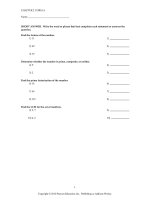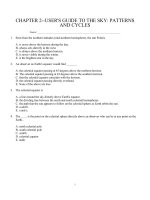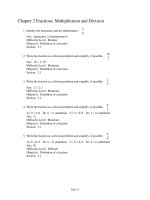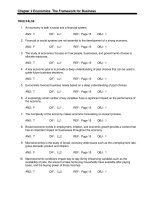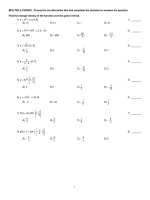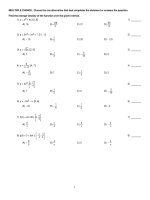Get fit stay well 2nd edition hopson test bank
Bạn đang xem bản rút gọn của tài liệu. Xem và tải ngay bản đầy đủ của tài liệu tại đây (1.22 MB, 9 trang )
CHAPTER
1
Changing Personal Behaviors
for Optimal Wellness
Overview
This chapter begins with a discussion of wellness as a personalized definition of individual
health. A central tenet of wellness is physical fitness, but the concept also embraces highquality medical care, nutritious food, good exercise facilities, and social support networks.
Wellness applies primarily to physicality, but also implies dimensions of the intellect, emotional responses, spirituality, and connectedness to one’s environment and social community,
as well as financial security and occupational satisfaction. Keeping all these variables in
balance produces overall wellness, which has been demonstrated to produce longer, healthier
lives in individuals and better conditions for society as a whole.
The pursuit of wellness is largely a function of behavior change, a multi-step process that
involves 1) understanding the steps required for change; 2) an increase in self-awareness;
3) contemplation of the approaching change; 4) correct preparation for change; and 5) taking
the proper action to expedite an efficient and lasting outcome.
Learning Outcomes
1. Identify your current place on the wellness continuum.
2. Describe the dimensions of wellness and how they are interconnected.
3. Explain the benefits of wellness for individuals and for society as a whole.
4. Determine your stage in the behavior change process for one or more behaviors.
5. List your fitness and wellness goals using the SMART goal-setting guidelines.
6. Commit to fitness and wellness by filling in a behavior change contract.
7. Learn and use strategies for keeping your behavior change on track.
Lecture Outline
Case Study: Carlos
Like Carlos, many college students are faced with enormous change and stress associated
with academic performance and physical development. Wellness, as a personalized aspect of
“health,” describes a vibrant state in which a person enjoys life to the fullest, adapts readily to
challenges, and participates effectively in surrounding society. As an entering freshman,
Carlos seeks to better manage his life with its normal illnesses, depressions, and frustrations.
Copyright © 2013 Pearson Education, Inc.
1
Key Terms: wellness, physical fitness
Figures:
Figure 1.1
The top 10 wellness impacts
on college performance.
PPT Slide: 3
Digital Transparency Master: Figure 1.1
I. Where Am I on the Wellness Continuum?
Taken together, your levels of wellness in each dimension determine your place along the
wellness continuum, a spectrum of wellness states ranging from optimal in one direction to
irreversible damage in the opposite direction. Understanding where you are on the wellness
continuum is a good starting point for achieving new wellness goals.
Key Term: wellness continuum
Figures:
Figure 1.2
The double-headed arrow
depicts the continuum of
wellness states.
PPT Slide: 4
Digital Transparency Master: Figure 1.2
II. What Are the Dimensions of Wellness?
A. Physical Wellness
Physical wellness is composed of all aspects of a sound body, including physical fitness, a
state in which muscular strength, lung capacity, flexibility, body composition, and other
physical attributes allows us to work and exercise without undue strain or injury. Diet, level
of physical activity, sleep patterns, use of alcohol and tobacco, and many other factors help
determine physical wellness.
2
INSTRUCTOR RESOURCE AND SUPPORT MANUAL FOR GET FIT, STAY WELL! 2/E
Copyright © 2013 Pearson Education, Inc.
B. Social Wellness
Social wellness is the ability to have satisfying interpersonal relationships and maintain
social connectedness. Contributing to social wellness are an ability to communicate effectively, a capacity to establish intimacy through trust and acceptance, a willingness to ask for
and give support, and many other factors.
C. Intellectual Wellness
Intellectual wellness is the ability to think effectively in order to solve problems and meet
life’s challenges. It requires an ability to use sound reasoning and make careful decisions, to
learn from successes and mistakes, to organize tasks, to maintain a sense of humor, and to
manage personal finances responsibly.
D. Emotional Wellness
Emotional wellness is the ability to control your emotions and express them appropriately at
the right times. Contributing to emotional wellness are self-esteem, self-confidence, an
ability to cope with loss and other challenges, and an ability to balance emotional dependence and independence.
E. Spiritual Wellness
Spiritual wellness may involve a belief in a supreme being, adherence to a way of life
prescribed by a particular religion, or a feeling of unity or oneness with others and with
nature. It also includes having a sense of meaning or value in life.
F. Environmental Wellness
Environmental wellness entails understanding how the environment can positively or
negatively affect you, and how your actions affect the environment. It includes occupational
wellness—that is, access to a safe and healthy workplace.
G. Related Dimensions of Wellness
1. Occupational Wellness
2. Financial Wellness
H. Balancing Your Wellness Dimensions
Key Terms: physical wellness, social wellness, intellectual wellness, emotional wellness,
spiritual wellness, environmental wellness, occupational wellness, financial wellness
Figures:
Figure 1.3
Wellness is an optimal level of
health in six interconnected
dimensions of human
experience.
Copyright © 2013 Pearson Education, Inc.
CHAPTER 1
Changing Personal Behaviors for Optimal Wellness
3
PPT Slides: 5–11
Digital Transparency Master: Figure 1.3
Labs: 1.1 Assess Yourself: How Well Are You?; 1.2 Learn a Skill: Chart Your Personal
Wellness Balance
III. Why Does Wellness Matter?
A. Good Wellness Habits Can Help You Live a Longer, Healthier Life
Maintaining good wellness habits can help extend your overall life expectancy, as well as
your years of healthy life. That’s because sound wellness choices—such as wearing a seat
belt; avoiding smoking, drugs, and alcohol abuse; eating a healthful diet; and engaging in
regular physical activity—reduce your risk of traumatic injury and chronic disease. Specifically, living a sedentary lifestyle, in which a person exerts physical effort only for required
daily tasks and not for leisure-time exercise, increases the risk of obesity, high blood
pressure, and other diseases.
B. Good Wellness Habits Benefit Society as a Whole
A population with high levels of wellness is happier, is more productive, and spends less
money on health care. America’s national health priorities are summarized in Healthy
People 2020, which has four broad goals: 1) attain high-quality, longer lives free of
preventable disease, disability, injury, and premature death; 2) achieve health equity,
eliminate disparities, and improve the health of all groups; 3) create social and physical
environments that promote good health for all; and 4) promote quality of life, healthy
development, and healthy behaviors across all life stages.
Key Terms: sedentary
Figures:
Figure 1.4
Healthy life expectancy is a
subset of overall life
expectancy.
4
Figure 1.5
The leading causes of death
among Americans ages
20–24.
Figure 1.6
The leading causes of death
among Americans overall.
INSTRUCTOR RESOURCE AND SUPPORT MANUAL FOR GET FIT, STAY WELL! 2/E
Copyright © 2013 Pearson Education, Inc.
Figure 1.7
Regular physical activity
results in many health
benefits.
Figure 1.8
Overweight and obese adults
are now the clear majority.
PPT Slides: 12–18
Digital Transparency Masters: Figure 1.4, Figure 1.5, Figure 1.6, Figure 1.7, Figure 1.8
Lecture Launcher Video: Months to a Healthier Lifestyle
IV. How Can I Change My Behavior to Increase My Wellness?
The following five basic steps inspired by the transtheoretical model can help you change
your behavior.
A. Step One: Understand the Stages of Behavior Change
Behavior change is an organized, deliberate effort to alter or replace an existing habit or
pattern of activity. It is not an event, but a process: research shows that we must go through
a series of mental and emotional stages over a period of months to adequately prepare
ourselves for behavior change. The transtheoretical model of behavior change, developed by
psychologists James Prochaska and Carlo DiClemente, delineates the following six stages of
behavior change:
1. In the precontemplation stage, people have no intention of changing.
2. In the contemplation stage, people recognize they have a problem and need to address
it, but they may languish in this stage for months or even years.
3. The preparation stage is characterized by careful thought about how to go about
changing the behavior; for instance, in this stage, it is common for people to formulate
a plan for change. Most people in this stage are within about a month of taking action.
4. In the action stage, people begin to execute their plan. Publicly stating the desire to
change, enlisting other people’s help, and setting realistic goals are steps that promote
success in this stage.
5. The maintenance stage is characterized by vigilance, attention to detail, and long-term
commitment as people seek to prevent a relapse into old habits. Participating in a
support group or similar resource can promote success in this stage. If you have
continued the new action for six months or longer, you’re in the maintenance stage.
6. While not an original stage of behavior change, relapse is something that happens
periodically for most people trying to change behaviors. Common causes of relapse
include overconfidence, daily temptations, stress or emotional distractions, and putting
yourself down. It is important to guard against relapse by getting help from a support
group or campus resources when needed.
7. At the termination stage, the new behavior is ingrained. This is the last step in the
process of behavior change.
Copyright © 2013 Pearson Education, Inc.
CHAPTER 1
Changing Personal Behaviors for Optimal Wellness
5
B. Step Two: Increase Your Awareness
1. Staying physically fit through focused activity every day is probably the single most
important wellness behavior you can adopt.
2. Eating healthily is a cornerstone of overall health. Consume the same approximate
number of calories that you burn each day. Limit your consumption of simple sugars,
animal fats, solidified vegetable fats (trans fats), and salt (sodium). Eat plenty of fiber,
including whole grains, fruits, and vegetables.
3. Managing your weight removes stress from your body and improves a host of physical
functions. Steps you can take toward maintaining a healthful weight include staying
physically active and eating a healthy diet.
4. Managing your stress promotes wellness and protects the body against disease and
illness. High levels of unrelieved stress can contribute to poor health. Physical activity,
social support, relaxation breathing, and other techniques can help you manage your
stress.
5. A clear path to personal wellness is to avoid smoking, drugs, and alcohol abuse. These
behaviors manipulate the brain chemically and carry high risks for illness and traumatic injury and death.
6. Be aware of potential accidents, injuries, and the risk of diseases. Adopting behaviors
that reduce the risk of motor vehicle accidents and traumatic injuries and promote
fitness and wellness is the core of prevention.
C. Step Three: Contemplate Change
1. Examine current habits and patterns. These include, for example, your level of
physical activity, your diet, your consumption of alcohol, and so forth. Ask yourself
how long the behavior has been going on, how often it occurs, how serious its
consequences are, why you do it, what situations trigger it, and what other people
are involved.
2. Assess current beliefs and attitudes. Before you can successfully change a behavior,
you must believe that your current behavior pattern could lead to a serious problem.
You must also believe that you personally are quite susceptible to developing the
problem.
3. Assess your motivation. Your motivation is your inducement to change a behavior.
Both external motivations—those that come from someone or something else—and
internal motivations—those that come from inside yourself—can induce you to
change if they become part of your sense of self. The degree to which you believe in
your own abilities is your self-efficacy. Your conviction that you can control events
and factors in your life is your locus of control.
4. Target a behavior for change. Choose one well-defined habit, or target behavior, as
your initial focus for change.
D. Step Four: Prepare for Change
1. Observe role models and the behaviors they practice as a guide to what can work in
your life.
2. Set realistic goals and objectives that are both achievable and in line with what you
truly want as an outcome.
6
INSTRUCTOR RESOURCE AND SUPPORT MANUAL FOR GET FIT, STAY WELL! 2/E
Copyright © 2013 Pearson Education, Inc.
3. Anticipate and overcome barriers to change and other potential stumbling blocks to
help you prepare for behavior change.
a. Overambitious goals can derail behavior change.
b. Self-defeating beliefs and attitudes can impede successful change.
c. Failing to accurately assess your current state of wellness could block progress.
d. Lack of support and guidance can also act as a barrier to change.
4. Make a commitment through a strongly worded statement, either verbally or through a
written behavior change contract.
E. Step Five: Take Action to Change
1. Visualize yourself engaging in the new behavior.
2. Control your environment so that you don’t encounter people or situations that tend to
trigger your unwanted behavior.
3. Change your self-talk—that is, the way you think and talk to yourself. For example,
replace thoughts of failure with positive reminders that the desired change is within
your control.
4. Learn to “counter”—that is, to substitute a desired behavior for an undesirable one.
For instance, chew a piece of sugarless gum instead of smoking a cigarette.
5. Practice “shaping”—that is, making a series of small changes that slowly progress.
6. Reward yourself for successes—for example, by scheduling an enjoyable activity or
purchasing a gift for yourself.
7. Use writing as a wellness tool. “Journaling,” or writing personal experiences, interpretations, and results in a journal or notebook, is an important skill for behavior change.
One helpful extension of journaling is a document called a behavior change contract,
which clarifies the goals and steps you plan to take, as well as the rewards you will
enjoy for sticking with the program.
Key Terms: behavior change, stages of behavior change, motivation, self-efficacy, locus of
control, target behavior, barrier to change, behavior change contract, countering, journaling
PPT Slides: 19–26
Lab: 1.3 Plan for Change: Create a Behavior Change Contract
Lecture Launcher Video: New Year’s Resolutions
Take Charge of Your Health!: Worksheet 1: Health Behavior Assessment; Worksheet 2:
Weekly Behavior Change Evaluation; Worksheet 3: Multidimensional Health Locus of
Control
Lab Activities
Lab 1.1
Assess Yourself: How Well Are You?
This lab helps students assess their current level of wellness in each of the six dimensions and
identify which wellness areas to target for behavior change.
Lab 1.2
Learn a Skill: Chart Your Personal Wellness Balance
This lab helps students learn how to chart their current personal wellness balance and identify
the wellness areas in which they would like to improve.
Copyright © 2013 Pearson Education, Inc.
CHAPTER 1
Changing Personal Behaviors for Optimal Wellness
7
Lab 1.3
Plan for Change: The Behavior Change Contract
This lab introduces students to the process of writing a behavior change contract and planning
for new lifestyle behaviors, and it serves as a model for other behavior change plans in subsequent chapters.
For additional labs; Take Charge of Your Health! Worksheets; and Activate, Motivate,
& Advance sample fitness and wellness programs, see this book’s website at
www.pearsonhighered.com/hopson.
Additional Chapter Activities
Discussion Questions
1. What is the difference between wellness and physical fitness?
2. What are some impediments to academic performance resulting from poor states of wellness and/or fitness?
3. Describe some of the ways that different aspects of the dimensions of wellness overlap or
intersect.
4. What are some key challenges people might face in attaining a higher state of wellness in
a given dimension?
5. How does the wellness continuum operate?
6. What are some problems with a sedentary lifestyle?
7. Describe several preventable disease risk factors.
8. What are the leading causes of death among young Americans? Which of these are
preventable?
9. Describe and explain the stages of behavior change. In what ways is each stage
important?
10. What might be a central challenge of the termination phase?
11. Have you ever been “stuck” at a stage described in this chapter? What did you do to
overcome it; or, if not, why do you think you didn’t?
12. How does journaling or recording your experience in detail assist in making positive
behavior changes?
13. What are the key aspects of a behavior change contract?
14. How does locus of control come into play in behavior change? What is it and why is it
important?
15. Describe an example of countering.
Critical Thinking Questions
1. Explain the benefits of wellness for individuals and for society as a whole.
2. Pick a behavior you would like to change in your own life, and explain how the technique of “shaping” might be used to modify that behavior.
3. Discuss the ways you should be especially self-aware when undertaking the pursuit of
wellness.
8
INSTRUCTOR RESOURCE AND SUPPORT MANUAL FOR GET FIT, STAY WELL! 2/E
Copyright © 2013 Pearson Education, Inc.
Lecture Launcher Video Discussion Questions
Months to a Healthier Lifestyle
1. What are the steps that Dr. Oz recommends you take in order to improve your life expectancy in terms of food and exercise? What are some of the ways in which you can incorporate these steps into your daily life?
2. What are the six basic health numbers that Dr. Oz suggests everyone should know? What
are some of the ways in which you can ascertain and track these numbers?
3. Why is practicing your balance important? Explain how balance affects the brain.
4. Explain what you think Dr. Oz means by “putting it all together” at the end of this video.
What are some ways in which you can start to organize your life in order to improve your
overall health?
In-Class Activity
Ask students to identify a behavior they would like to change, outline the steps they’ll take,
list the factors that might influence this change, and write out three specific objectives to help
them attain it.
Community Action
Have students investigate the state of wellness in their dormitories, schools, or communities
using the dimensions of wellness as criteria. Have them then look into resources that might be
of use to help those groups overcome shortcomings that may be having a negative effect on
health and wellness.
Media Resources
See the following approved websites to learn more about fitness and wellness topics:
American College of Sports Medicine: www.acsm.org
American Heart Association: www.heart.org/HEARTORG/
American Medical Association: www.ama-assn.org
CDC Wonder: wonder.cdc.gov
FDA Information for Consumers: www.fda.gov/ForConsumers/default.htm
Harvard School of Public Health, World Health News: www.worldhealthnews.harvard.edu
Healthy People 2020: www.healthypeople.gov
Mayo Clinic Health Information: www.mayoclinic.com/health-information
National Center for Health Statistics: www.cdc.gov/nchs/
National Health Information Center: www.health.gov/nhic
President’s Council on Fitness, Sports & Nutrition: www.fitness.gov
U.S. Department of Health and Human Services: www.healthfinder.gov
USDA Food and Nutrition Information Center:
WebMD: www.webmd.com
Web addresses are subject to change. See also this book’s website at
www.pearsonhighered.com/hopson for updates and additional links related to topics in this
chapter.
Copyright © 2013 Pearson Education, Inc.
CHAPTER 1
Changing Personal Behaviors for Optimal Wellness
9

